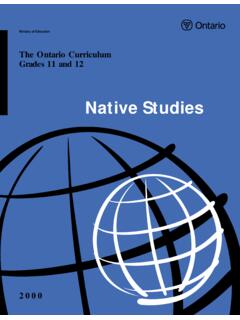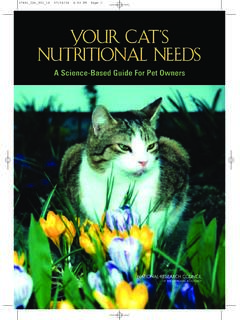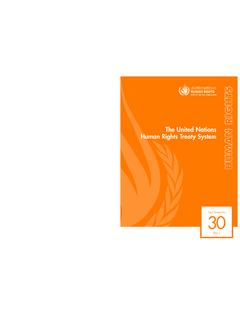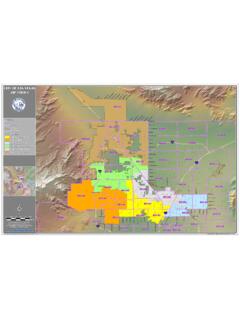Transcription of LAND-CAPABILITY CLASSIFICATION - USDA
1 LAND-CAPABILITY CLASSIFICATION Agriculture Handbook No. 210 SOIL CONSERVATION SERVICE DEPARTMENT OF AGRICULTURE Growth Through Agricultural Progress For sale by the Superintendent of Documents, Government Printing OflSce Washington 25, - Price 15 cents FOREWORD Since soil siuveys ore based on all of the characteristics of soils that influence their use and management, interpretations are needed for each of the many uses. Among these interpretations the grouping of soils into capability units, subclasses, and classes is one of the most important. This grouping serves as an introduction of the soil mop to farmers and other land users developing conservation plans. As we have gained experience in this grouping, the definitions of the categories have improved. It is the purpose of this publication to set forth these definitions. In using the capability CLASSIFICATION , the reader must continually recall that it is on interpretation.
2 Like other interpretations, it depends on the probable interactions between the kind of soil and the alternative systems of management. Our management systems ore con- tinually changing. Economic conditions change. Our knowledge grows. land users ore continually being offered new things, such as new machines, chemicals, and plant varieties. The new technology applies unevenly to the various kinds of soil. Thus the grouping of any one kind of soil does not stay the same with changes in technology. That is, new combinations of practices increase the productivity of some soils more than others, so some are going up in the scale whereas others are going down, relatively. Some of our most productive soils of today were considered poorly suited to crops a few years ago. On the other hand, some other soils that were once regarded as good for cropping ore now being used more productively for growing pulpwood.
3 These facts in no way suggest that we should not make interpretations. In fact, they become increasingly important as technology grows. But these facts do mean that soils need to be rein- terpreted and regrouped after significant changes in economic conditions and technology. Besides the capability CLASSIFICATION explained in this publication, other important in- terpretations ore made of soil surveys. Examples include groupings of sous according to crop-yield predictions, woodland suitability, range potentiaHty, wildlife habitat, suit- ability for special crops, and engineering behavior. Many other kinds of special group- ings are used to help meet local needs. CHARLES E. KELLOGO Assistant Administrator for Soil Survey Soil Conservation Service CONTENTS Page Assumptions 3 capability classes 6 land suited to cultivation and other uses 6 land limited in use generally not suited to cultivation 9 capability subclasses 10 capability units 12 Other kinds o soil groupings 12 Criteria for placing soils in capability classes 13 Arid and semiarid stony, wet, saline-sodic, and overflow soils 14 Climatic limitations 15 Wetness limitations 16 Toxic salts 16 Slope and hazard of erosion 17 Soil depth 18 Previous erosion 18 Available moisture-holding capacity 18 Glossary 18 Issued September 1961 LAND-CAPABILITY CLASSIFICATION By A.
4 A. Klingebiel and P. H. Montgomery, soil scientists. Soil Conservation Service The standard soil-survey map shows the different kinds of soil that are significant and their location in relation to other features of the landscape. These maps are intended to meet the needs of users with widely different problems and, therefore, contain considerable detail to show important basic soil differences. The information on the soil map must be explained in a way that has meaning to the user. These explanations are called interpretations. Soil maps can be interpreted by ( 1 ) the individual kinds of soil on the map, and ( 2 ) the grouping of soils that behave similarly in responses to management and treatment. Because there are many kinds of soil, there are many in- dividual soil interpretations. Such interpretations, however, provide the user with all the information that can be obtained from a soil map.
5 Many users of soil maps want more general information than that of the individual soil-mapping unit. Soils are grouped in different ways according to the specific needs of the map user. The kinds of soil grouped and the varia- tion permitted within each group differ according to the use to be made of the grouping. The capability CLASSIFICATION is one of a number of interpretive groupings made primarily for agricultural purposes. As with all interpretive groupings the capability CLASSIFICATION begins with the individual soil-mapping units, which are building stones of the system (table 1). In this CLASSIFICATION the arable soils are grouped according to their potentialities and limitations for sustained production of the common cultivated crops that do not require specialized site conditioning or site treatment. Nonarable soils (soils un- suitable for longtime sustained use for cultivated crops) are grouped ac- cording to their potentialities and limitations for the production of perma- nent vegetation and according to their risks of soil damage if mismanaged.
6 The individual mapping units on soil maps show the location and extent of the different kinds of soil. One can make the greatest number of precise statements and predictions about the use and management of the individual mapping units shown on the soil map. The capability grouping of soils is designed ( 1 ) to help landowners and others use and interpret the soil maps, (2) to introduce users to the detail of the soil map itself, and (3) to make possible broad generalizations based on soil potentialities, limitations in use, and management problems. The capability CLASSIFICATION provides three major categories of soil group- ings : (1) capability unit, (2) capability subclass, and (3) capability class. TABLE L Rela onship of soil-mapping unit to capability CLASSIFICATION Soil-mapping unit A soil mapping unit is a portion of the landscape' that has similar characteristics and qualities and whose limits are fixed by precise definitions.
7 Within the carto- graphic limitations and consider- ing the purpose for which the map is made, the soil mapping unit is the unit about which the greatest number of precise state- ments and predictions can be made. The soil mapping units provide the most detailed soils informa- tion. The basic mapping units are the basis for all interpretive groupings of soils. They furnish the information needed for de- veloping capability units, forest site groupings, crop suitability groupings, range site groupings, engineering groupings, and other interpretive groupings. The most specific management practices and estimated yields are related to the individual mapping unit. capability unit A capabihty unit is a grouping of one or more individual soil map- ping units having similar po- tentials and continuing limita- tions or hazards. The soils in a capability unit are sufficiently uniform to (a) produce similar kinds of cultivated crops and pasture plants with similar man- agement practices, (b) require similar conservation treatment and management under the same kind and condition of vegetative cover, (c) have com- parable potential productivity.
8 The capability unit condenses and simplifies soils information for planning individual tracts of land , field by field. Capa- bility units with the class and subclass furnish information about the degree of limitation, kind of conservation problems and the management practices needed. capability subclass Subclasses are groups of capa- bility units which have the same major conservation problem, such as e Erosion and runoff. w Excess water. s Root-zone limitations. c Climatic limitations. The capability subclass pro- vides information as to the kind of conservation problem or limitations involved. The class and subclass together provide the map user infor- mation about both the degree of limitation and kind of prob- lem involved for broad pro- gram planning, conservation need studies, and similar purposes. capability class capability classes are groups of capability subclasses or capa- bility units that have the same relative degree of hazard or limitation.
9 The risks of soil damage or limitation in use become progressively greater from class I to class VIII. The capability classes are useful as a means of introducing the map user to tlie more detailed information on the soil map. The classes show the location, amount, and general suita- biUty of the soils for agricul- tural use. Only information concerning general agricul- tural limitations in soil use are obtained at the capability class level. The first category, capability unit, is a grouping of soils that have about the same responses to systems of management of common cultivated crops and pasture plants. Soils in any one capability unit are adapted to the same kinds of common cultivated and pasture plants and require similar alterna- tive systems of management for these crops. Longtime estimated yields of adapted crops for individual soils within the unit under comparable management do not vary more than about 25 percent.
10 ^ ^ The second category, the subclass, is a grouping of capability units having similar kinds of limitations and hazards. Four general kinds of limitations or hazards are recognized: (1) Erosion hazard, (2) wetness, (3) rooting- zone limitations, and (4) climate. The third and broadest category in the capability CLASSIFICATION places all the soils in eight capabihty classes. The risks of soil damage or limita- tions in use become progressively greater from class I to class VIII. Soils in the first four classes under good management are capable of producing adapted plants, such as forest trees or range plants, and the common culti- vated field crops ^ and pasture plants. Soils in classes V, VI, and VII are suited to the use of adapted native plants. Some soils in classes V and VI are also capable of producing specialized crops, such as certain fruits and ornamentals, and even field and vegetable crops under highly intensive management involving elaborate practices for soil and water conservation.















